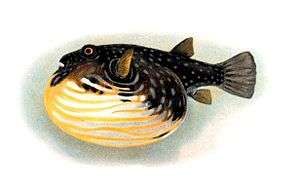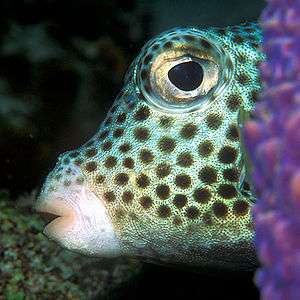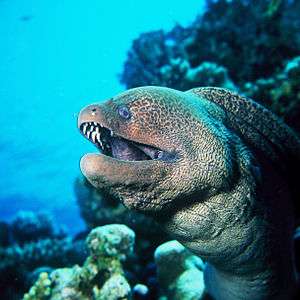Poisonous fish

The puffer fish is the most poisonous fish in the world.
Poisonous fish are fish that are poisonous to eat. They contain toxins in their body that the digestive system does not destroy if the fish are eaten.[1] Venomous fish also contain toxins, but differ from poisonous fish in the way they deliver the toxin. Venomous fish bite, sting, or stab and don't necessarily cause poisoning if they are eaten, since the digestive system often destroys their venom.[1]
Examples
- The puffer fish is the most poisonous fish in the world, and the second most poisonous vertebrate after the golden dart frog. The active substance, tetrodotoxin, found in the internal organs and sometimes also the skin, paralyzes the diaphragm muscles of human victims, who can die from suffocation. In Japan, skilled chefs use parts of a closely related species, the blowfish to create a delicacy called "fugu", including just enough toxin for that "special flavour".
- The spotted trunkfish is a coral reef fish which secretes a ciguatera toxin from glands on its skin. The spotted trunkfish is a reef fish which secretes a colourless ciguatera toxin when touched. The toxin is only dangerous when ingested, so there's no immediate harm to divers. However, predators as large as nurse sharks can die as a result of eating a trunkfish.[2]
- The giant moray is a reef fish at the top of the food chain. Like many other apex reef fish, it is likely to cause ciguatera poisoning if eaten.[3][4] Outbreaks of ciguatera poisoning in the 11th to 15th centuries from large, carnivorous reef fish, caused by harmful algal blooms, could be a reason why Polynesians migrated to Easter Island, New Zealand, and possibly Hawaii.[5][6]
-

The spotted trunkfish is a coral reef fish which secretes a ciguatera toxin from glands on its skin.
-

The giant moray, a coral reef fish at the top of the food chain is also likely to cause ciguatera poisoning if eaten.
See also
- Aquatic toxicology
- Ciguatera
- Haff disease
- Hallucinogenic fish
- Ichthyoallyeinotoxism
- Salmon poisoning disease
- Scombroid food poisoning
References
- 1 2 Poisonous vs. Venomous fish: What’s the difference? Reef Biosearch. Retrieved 17 July 2009.
- ↑ Froese, Rainer and Pauly, Daniel, eds. (2009). "Lactophrys bicaudalis" in FishBase. July 2009 version.
- ↑ Lieske, E. and Myers, R.F. (2004) Coral reef guide; Red Sea London, HarperCollins ISBN 0-00-715986-2
- ↑ Froese, Rainer and Pauly, Daniel, eds. (2009). "Gymnothorax javanicus" in FishBase. July 2009 version.
- ↑ Rongo T, Bush M and van Woesik R (2009) "Did ciguatera prompt the late Holocene Polynesian voyages of discovery?" Journal of Biogeography, 36 (8) 1423-1432.
- ↑ Voyages of discovery or necessity? Fish poisoning may be why Polynesians left paradise PhysOrg.com, 18 May 2009.
This article is issued from Wikipedia - version of the 8/16/2016. The text is available under the Creative Commons Attribution/Share Alike but additional terms may apply for the media files.
